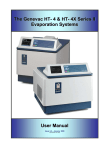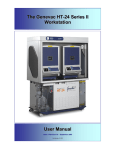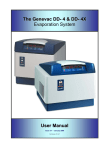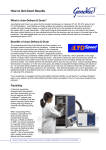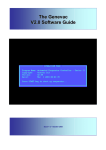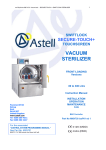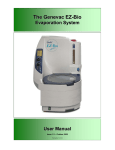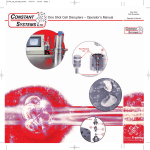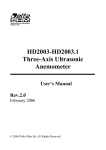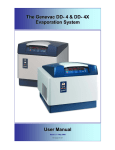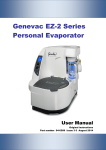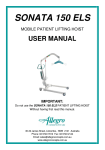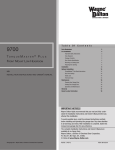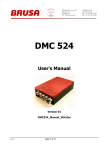Download The Genevac HT-24 Series II Workstation Systems User Manual
Transcript
The Genevac HT-24 Series II Workstation Systems User Manual Issue 2-1 – January 20098 Part Number 10-1562 Contents Introduction...................................................2 Shutting Down ............................................ 33 Safety .............................................................6 Options Menu ............................................. 34 Safety Symbols ...................................................6 Genevac Evaporators and Combustible Solvents ............................................................................6 Electrical Safety ..................................................6 Limitations of Use................................................6 Options ..........................................................7 Delivery and installation ..............................8 Starting a Run............................................. 35 The Evaporation Process .......................... 36 Optimising a Run........................................ 37 Limiting the Chamber Pressure....................... 37 Linking Runs.................................................... 37 Pre-programmed Runs .................................... 37 Checking the delivery..........................................8 Arranging commissioning....................................8 Training ...............................................................8 Positioning the evaporator ..................................8 Getting the Best from the System ............ 39 Safe Loading of Rotor – General Document ........................................................................9 Auto Defrost Drain ..................................... 43 Nomenclature......................................................9 Use of Correct Accessories ..............................10 Adherence to Mass Limit ..................................10 Safe Loading of Sample Holders into Swings...11 Balancing Sample Holders and Swings ............12 Good Procedural Practice.................................13 Loading the Rotor.......................................13 Solvents.......................................................14 Common Acceptable Solvents..........................14 Genevac and the ATEX Directive .....................14 Waste Solvent Container ..................................15 Getting started ............................................16 Setting up ..........................................................16 Switching on......................................................16 Unlocking the Door............................................17 Unlocking the Door Remotely ...........................17 Locking the Door ...............................................18 Extra Precautions for Fume Hood Systems......18 Using SampleGuard™ ................................19 Verifying the Sample Guard Calibration............20 Evaporator Controls ...................................21 Control Screens: an Overview...................22 Select Run Screen ......................................23 Functions of the Menu Bar................................24 Entering Control Data........................................24 Run Data Screen .........................................25 Run Parameter Details......................................25 Run Log Screen ..........................................31 Alarms ...............................................................31 Routine Checks ................................................ 39 Tips for Improving System Performance.......... 39 Run Parameters Quick Reference ................... 40 What is Auto-Defrost & Drain? ......................... 43 Benefits of Auto-Defrost & Drain ...................... 43 Flexibility........................................................... 43 How it Works .................................................... 44 When to use Auto-Defrost and Drain ............... 44 When not to use Auto-Defrost and Drain ......... 45 Drying HPLC Fractions .................................... 45 Lyophilising HPLC Fractions ............................ 46 Notes on Lyophilisation .................................... 46 Drying Mixed High and Low Boiling Point Samples ........................................................... 47 Problem Prevention ................................... 48 Condensation ................................................... 48 TFA Creep........................................................ 48 Bumping ........................................................... 48 Maintenance................................................ 49 Cleaning the Sample Holders and Swings....... 49 Cleaning the Chamber, Rotor and Swings....... 49 Scroll Pump ...................................................... 49 Planned Maintenance and Service .................. 50 Moving the System........................................... 50 Additional Equipment ................................ 51 Help.............................................................. 52 Technical Data ............................................ 53 EC Declaration of Conformity ................... 55 Warranty Statement ................................... 55 Amendment Control Form......................... 56 Useful Information...................................... 58 Genevac HT-24 – series II Workstation Introduction The HT-24 Workstation provides very high performance, occupies the minimum amount of laboratory space and is easy to use. The workstation comprises a trolley (with the option of an integrated fume hood) two condensers a high vacuum Scroll Pump and a Waste Solvent Container. The workstation can accommodate the following evaporator combinations. Two HT8-SII, two HT12SII, a combination of both, or one single evaporator. This manual refers to the evaporation system on the left hand side, as system 1 (or position 1). Scroll Pump & Catch Pot Door Open HT-24 Workstation Front View Waste Solvent Container Door Open Two HT12-SII evaporators installed. Complete with optional fume hood. Note: The fume hood has 3 Sliding doors (not shown) for easy access. Either evaporator can run independently or both can run together. Each evaporator can simultaneously remove a different solvent, provided the solvents do not react within the drain circuit and waste container. Sample processing can also be staggered; whilst one unit runs, the other can be emptied and reloaded. Page 2 of 60 10-1562 Issue 2-1 – January 2009 Genevac HT-24 – Series II Workstation Using smart technology integrated with the Genevac V2 evaporator software, each condenser is capable of chilling, defrosting and draining independently of the other. An Automatic pump and drain valve system removes solvent from the condenser pots. Note: The Waste Solvent Container must be emptied periodically. The drain pump only operates if the Waste Solvent Container is fitted, and the Waste Solvent Container Door is shut. A load cell monitors the amount of fluid in the Waste Solvent Container. A buzzer sounds, at a predetermined weight limit, and a WASTE FULL lamp illuminates on the control panel. Note: the volume of waste solvent varies according to the specific gravity of individual solvents. A staticdissipating safety device contacts the waste solvent at all times. WASTE FULL LED Illuminates when Waste Solvent Container is full OPEN CHAMBER 1 Press button to open evaporator 1 OPEN CHAMBER 2 Press button to open evaporator 2 OFF button. Press to turn off HT-24 and evaporators ON button. Press to turn on HT-24 and evaporators EMERGENCY STOP Press to use. Used in an emergency to isolate Mains Power to the HT-24 POWER ON LED Illuminates when HT-24 is switched on Workstation Control Panel Each evaporator has an LCD screen which shows the status of the relevant system. evaporator can be controlled independently via its own keypad. Each Evaporator Screen and Keypad Simple to use up-down controls enable the run time, rotor and chamber temperatures to be set in an instant. Single push buttons set the other functions. 10-1562 Issue 2-1 – January 2009 page 3 of 60 Genevac HT-24 – series II Workstation The two evaporators share a single scroll pump by means of a vacuum valve manifold. The valve manifold intelligently switches the pump to each evaporator on demand. The scroll pump is a dry vacuum pump, compact in size, air cooled and driven directly by a single-phase electric motor. Data Logging is available independently from each evaporator. Both evaporators can connect and log to the same PC. Data Connections x 2 & Waste Solvent Pump HT-24 Rear View Fume Hood rear panel removed for clarity Mains Power Supply Connections x 3 & Electrical Circuit Breakers The optional fume hood fits on top of the HT-24 workstation and provides a totally enclosed system. There are 3 transparent sliding doors in the front for easy access to the evaporators and a window in each side. An exhaust spigot in the roof provides for connection to a suitable fume extraction system. A flow meter is located in the top right corner to monitor performance of the extraction system. Page 4 of 60 10-1562 Issue 2-1 – January 2009 Genevac HT-24 – Series II Workstation Convenient pullout sample shelves provide assistance when loading / unloading the evaporators. Fume Hood Flow Meter Pullout Sample Shelves The evaporator control software offers the facility to auto program run parameters for any (recognised) solvent or mixture. Simply select the solvent(s) from a drop down menu enter details for volume and sample holder type, select Auto Program and optimised run parameters appear, highlighted in cyan, on the display screen. Solid-state case heaters and Coolheat radiant lamps heat the chamber and samples. The control of chamber temperature, sample holder temperature, vacuum ramping rate, chamber pressure, rotor speed and run time are all handled by an embedded PC. Lyophilisation (Freeze Drying) may be achieved by freezing samples before loading into an evaporator. Automatic end of run shut down may be programmed manually with a simple time setting, or may be achieved by automatic end of run prediction using Heat Flow or Sample Detection methods. The Run Progress screen has a fully featured graphical display, providing annotated plots for temperature and pressure. The control software enables the user to specify and store a library of up to 100 different evaporation profiles. Run profiles can also be linked to provide multi stage runs. Up to 100 different profile steps can be linked and iterative loops can also be programmed. With a maximum single run time of just below 100 hours, this makes the system extremely flexible. This manual will guide you through the start up requirements, set up needs and operation of the system to facilitate the most efficient procedure to protect your product’s integrity and to ensure optimum performance at all times. 10-1562 Issue 2-1 – January 2009 page 5 of 60 Genevac HT-24 – series II Workstation Safety Safety Symbols The following safety symbols are used throughout this manual and are defined as follows. Hazards that can be harmful to health, or lead to serious damage or injury. Possible risk to sample integrity. Genevac Evaporators and Combustible Solvents Please note it remains the responsibility of the user to consider safety when evaporating any combustible solvents, and to place the system in a well-ventilated environment. Genevac's position regarding evaporation of such solvents, particularly with respect to the European ATEX directive, is available on our website or from your local sales representative. Electrical Safety Important: the system must be earthed. This evaporation system is a safety class 1 product according to IEC classification. It must never be used with any interruption to the safety earth conductor. It is an installation category II product and is intended to operate from normal, single-phase power supplies. This evaporator is designed for use in a degree 1 environment (no pollution, or only dry non-conductive pollution). Any maintenance or repair of this product must be carried out by Genevac personnel (or approved representatives of Genevac) using only approved spare parts. Limitations of Use The HT-24 workstation is unsuitable for use under the following circumstances: • • • Page 6 of 60 With strong mineral acids such as HCl and HBr at all concentrations, unless specifically built to order. Evaporating diethyl ether and other similar low auto-ignition solvents. For use as a pressure vessel. 10-1562 Issue 2-1 – January 2009 Genevac HT-24 – Series II Workstation Options Available options include: • • • • Bump protection (Dri-Pure ™) on one or both evaporators. High power Coolheat lamps on one or both evaporators. Low UV lamp lenses on one or both evaporators (not available with high power lamps). Built in fume extraction (hood and pipe system). Data Logging is available independently from each evaporator. Dependent on user hardware, both evaporators could be logged to the same PC. The easy-to-use package provides the data needed for process and quality control. Hardware Required: • • • • PC running ‘Windows’ (95, 98, NT, 2000 or XP). Around 5Mbytes of free space on your hard drive. Serial Port on the PC or USB to Serial Adapter. Serial Cable to connect the PC to the Evaporator. Contact your sales representative for purchase and installation details. 10-1562 Issue 2-1 – January 2009 page 7 of 60 Genevac HT-24 – series II Workstation Delivery and installation Please unpack your system at the point of receipt in order to ease the movement of the component parts to the point of use. The HT-24 workstation must be commissioned by Genevac personnel or suitably trained Genevac representatives. Checking the delivery Check the contents of the delivery, against the delivery note, as soon as possible. Notify Genevac Ltd immediately if any parts are missing or damaged. (Refer to the back cover for contact details). Arranging commissioning Genevac Ltd will contact you prior to the delivery, to agree a date to commission your system. Training Commissioning will normally include training in the basic operation of the System. Further in house training is recommended to fully exploit the flexibility of the system. Do not allow personnel to operate the HT-24 workstation who lack the training or experience to comprehend the hazards that car arise when using the system. Personnel without such training require thorough instruction. The operating instructions within this manual may form the basis of that instruction. Positioning the evaporator Refer to the section entitled: Technical data for dimensions and a plan view drawing. Refer also, to the separate document entitled: Installation Requirements. Use the inbuilt jacks (as shown) to lift all four wheels clear of the floor when the workstation is in its final position. The back of the system may be positioned against a wall, although provision must be made for maintenance access. Leave suitable space on either side of the workstation to allow the waste solvent container door, and the pump and catch-pot door, to open. Thumbscrews retract or lower the inbuilt jacks Page 8 of 60 10-1562 Issue 2-1 – January 2009 Genevac HT-24 – Series II Workstation Safe Loading of Rotor – General Document Genevac are obliged to include the following information in its entirety, irrespective of the system type. As with all centrifuges, Genevac centrifugal evaporators must be loaded correctly to remove the risk of damage. Failure to correctly load a system can lead to unrecoverable loss of samples and damage to the system. This guide is intended for new users and also as a reminder for more experienced users. The principles outlined apply to all Genevac evaporators. The following instructions deal with various aspects of loading: • • • • • Use of correct swings and sample holders Observation of weight limits Safe loading of sample holders into swings Balancing of swings and sample holders Good procedural practice Nomenclature Some Genevac systems feature fixed rotors which have angled holes for individual tubes or holders. The following instructions are primarily concerned with the more common swung rotors. The new range of Genevac sample holders (blue in colour) include integral swing holders such as the example shown. Integral Swing / Tube Holder Tube Holder and Side-Bridge Swing Sample holders requiring a separate swing (or bucket) may also be used. Each of these swing types lifts straight out of the rotor. The ideal swing type depends on the sample holder required. A large range of sample holders is available. Load the tubes, vials, beakers or flasks into the sample holders, then place the sample holders in the swings. 10-1562 Issue 2-1 – January 2009 page 9 of 60 Genevac HT-24 – series II Workstation Use of Correct Accessories Genevac supply a wide range of sample holders to cover a variety of plate, tube, vial or flask formats. Where no holder is available, custom units can be made. To ensure that bespoke holders are suitable and approved for use, new sample holders may be designed in collaboration with the Genevac R&D department. Criteria for approval:• • • • • Mass within prescribed maximum limit. Matched sample holder mass within a set. Correct centre of gravity. Good thermal conductivity. Correct hole, form and size, tolerance to reduce risk of tube or vial breakage under centrifugal acceleration. All Genevac holders are designed with these constraints in mind. 3rd party accessories may not be. With the exception of microtitre plates, do not load any non-Genevac holders into a system without gaining approval from Genevac. Failure to comply may result in unrecoverable loss of samples, severe damage to equipment and invalidation of the warranty. All swings and holders must be approved for the Genevac system in which they are used (applicable particularly where Series I and Series II evaporators are used within the same laboratory). For example, some sample holders designed for use in Series II systems, might appear to fit in a Series I system, but would exceed the weight limitations. If in doubt, consult Genevac before using such holders. There are also instances where a sample holder intended for one tube or vial, becomes unsuitable if used with something else, even though it might appear that the alternative tube fits. The Genevac Accessories Brochure indicates the maximum tube length that each holder is designed to take. Always adhere to these limits. Similarly, sample holders intended for use in a Side-Bridge swing must not be used in an Open swing, even though they might appear to fit. The Genevac Accessories Brochure has a note: For use in Side-Bridge Swing by these items, but if in doubt, ask Genevac. Please note that some (not all) of the Bohdan Miniblock system sample holders significantly exceed the mass limitations of a Genevac system. If you plan to use Bohdan Miniblocks in a Genevac system, please contact Genevac for a list of the relevant weights. Adherence to Mass Limit The total mass that can be loaded onto each position of a Genevac swung rotor. This mass includes: • • • • The swing The sample holder The tubes or vials The sample solutions Do not exceed the mass limit under any circumstances. In most cases, with normal solvent volumes, sample holders sold by Genevac fall within the mass limit for a series II system. If in any doubt, load up a full swing and weigh it. Page 10 of 60 10-1562 Issue 2-1 – January 2009 Genevac HT-24 – Series II Workstation Safe Loading of Sample Holders into Swings This information is applicable where Series 1 and series II equipment is used in the same laboratory. Sample Holder rotated There are two possible ways in which a sample holder may be miss-loaded into an older type of swing. One is to rotate the sample holder such that its corners rest on the edges of the swing. The other is to place the sample holder so that one side rests on the edge of the swing. Both these modes of miss-loading are possible with a Series 1 open or standard swing, but are virtually impossible with a Series II swing. Care must still be taken when loading the samples. Sample Holder correctly seated The Series 1 design is easy to distinguish. The corners are not welded. Sample Holder on edge of swing The Series II swing has angled sides and rounded corners that are welded. Genevac offer an option to upgrade to the new range of sample holders and swings. This upgrade permanently avoids the possibility of mis-loading.. Sample Holder correctly seated 10-1562 Issue 2-1 – January 2009 page 11 of 60 Genevac HT-24 – series II Workstation Balancing Sample Holders and Swings Opposite pairs of swings must be balanced within 10g and the swings must be of the same type and version. Please note that there are several versions of Side Bridge Swings in circulation with a static weight ranging from 375g to 445g. Place swings of the same static weight, in diametric opposition on the rotor; ideally use the same version of swings in all four positions of each rotor level. Genevac systems have some inbuilt tolerance for imbalance, and a safety system which stops the rotor if the out-of-balance is unacceptably high. However, to minimise noise nuisance and wear-andtear the balance limit should always be observed. If the evaporator is to be partially loaded, always fill the top rotor level first. Then fill the second level, then the third (third level applies to HT12-SII evaporators only). Real loads may be balanced using Dummy samples. They must be of a similar solvent composition. For example, do not balance 200g of 50 / 50 - Water / Acetonitrile with 200g of water. Partway through the run, the acetonitrile evaporates but the water remains, resulting in an imbalance of 100g. Note that with a system such as the Fast-StackTM swing, balancing is slightly more complex. Suppose a Fast-StackTM Deepwell swing is used with two 96 well microtitre plates, 2ml per well. In one swing, the lower microtitre plate is empty, the upper microtitre plate is full, 1.8mls per well. On the other swing, the reverse is true. The two swings now weigh the same. However, if placed opposite each other in on a rotor, would be imbalanced. This is because when the swings rotate to their operating attitude, the centre of mass of one is at a different radius to that of the other. Swings are the same weight but not balanced It is also preferable to run the evaporator with all four swings fitted to each level of the rotor. If there are only enough samples to fill two swings, it is better to distribute the samples into four holders (or, at least, place two empty holders in the rotor). This reduces the mechanical stress on the rotor and helps to distribute the heat flow evenly between the samples. Page 12 of 60 10-1562 Issue 2-1 – January 2009 Genevac HT-24 – Series II Workstation Good Procedural Practice Finally, there are a few general rules for safe operation of a system: • • • • • Only permit users, familiar with all the issues outlined in this document, to operate the equipment. Only load swings and sample holders that are approved by Genevac. The same user should be responsible for loading and starting the system. Never leave the system unevenly loaded with the door closed. Someone may start it. Never start, or restart a system without checking it is evenly loaded, all sample holders are correctly seated and all holders swing freely. Miss-loading may result in unrecoverable sample loss, damage to equipment, and could void the warranty. Loading the Rotor Samples in the chamber are subjected to accelerations of up to 500G. The maximum load capacity is 1.5kg per swing. The load capacity includes tubes, solvent, sample, sample holder and swing. Always observe the following Precautions • Never exceed the maximum load capacity of 1.5 kg per swing. • Ensure tubes locate correctly in tube holders. • Locate sample blocks correctly in sample swings. • Load two or four tube holders in opposite and balanced configurations. • Distribute tubes in sample holders symmetrically. • Balance oppositely loaded pairs of sample holders to within 10g. Rotate the rotor by hand. Check that all tube holders and plates are correctly located and swing freely. Use only the sample holders supplied with the system, or that are specified for use with the system. Never use non Genevac approved sample holders. Genevac Ltd will not accept responsibility for any loss or damage incurred by improperly or excessively loaded rotors. 10-1562 Issue 2-1 – January 2009 page 13 of 60 Genevac HT-24 – series II Workstation Solvents Common Acceptable Solvents Density (g/cm3) Solvent Density Temp. (°C) Autoprogram Available Acetic Acid 1.05 20 N Acetonitrile (ACN) 0.79 20 Y Ammonium Hydroxide (NH3OH) 0.90 20 Y Chloroform (TCM) 1.48 20 Y Dichloroethane (DCE) 1.24 20 Y Dichloromethane (DCM) 1.33 20 Y Dimethylacetamide (DMAc) 0.94 20 Y Dimethylamine (DMA) 0.68 20 N Dimethylformamide (DMF) 0.94 25 Y Dimethylsulfoxide (DMSO) 1.10 20 Y Ethanol (EtOH) 0.79 20 Y Ethyl Acetate (EtAc) 0.90 20 Y Hexane (Hex) 0.65 20 Y Isopropanol 0.79 20 N Methanol (MeOH) 0.79 20 Y N-Methyl-2-pyrrolidone (NMP) 1.02 25 Y Pyridine 0.98 20 N Tetrahydrofuran (THF) 0.89 20 Y Toluene (PhMe) 0.87 20 Y Tri Ethyl Amine (TEA) 0.73 20 Y Trifluoroacetic acid (TFA) 1.54 20 Y Water 1.00 20 Y HCl, Thionyl Chloride or Di Ethyl Ether compatibilities are not available. Genevac and the ATEX Directive Please note that it remains the responsibility of the user to consider any solvents being evaporated within the context of the ATEX directive. The presence of solvents on the list above indicates only that they will not damage the system. If further information is required, please contact your Sales Representative or visit http://www.genevac.com/ Those solvents with a Y in the Autoprogram Available column are available from the Solvent drop down list when setting up a run. The solvents with an N against them must be entered using the Other option and the rest of the data entered manually. Page 14 of 60 10-1562 Issue 2-1 – January 2009 Genevac HT-24 – Series II Workstation Waste Solvent Container Empty the Waste Solvent Container periodically. An alarm sounds to indicate if the Waste Solvent Container becomes full. Open the Waste Solvent Container door, proceed as shown, then close the door. . Note: the system does not allow a new run to start if the Waste Solvent Container is full, or if the Waste Solvent Container Door is not closed. 10-1562 Issue 2-1 – January 2009 page 15 of 60 Genevac HT-24 – series II Workstation Getting started Data cable connectors The following notes provide basic instructions for set up, start up, and running the HT-24 evaporating system. Refer to the relevant sections of this manual for more detailed information on specific steps. Setting up Connect the 3 mains power leads to the rear of the system. Connect each power lead to a separate mains supply outlet. Do not connect the cables to a common mains distribution block. Mains power leads Fume hood is shown with Rear panel removed for clarity Switch on the mains supplies at source. Connect the date cables if required. Switching on Switch on each evaporator using the ON/OFF switch located on the service panel (towards the back, lower right hand side, of the evaporator). Note: For convenience, leave the evaporator switches permanently on, the HT-24 controls power distribution. Evaporator Service Panel Reset the EMERGENCY STOP button if it has been pressed. Do not use the emergency stop button to shut down the system on a regular basis. Press the Green power ON button, the POWER ON LED illuminates and both systems power up. Workstation Control Panel Page 16 of 60 10-1562 Issue 2-1 – January 2009 Genevac HT-24 – Series II Workstation Each evaporator displays the Software Control screen. Press the START key on the keyboard to access the Select Run screen. Note: The Select Run screen starts up at the last or most frequently used run. Unlocking the Door Select a system to use, press the door OPEN button and manually open the door. An evaporator door cannot be unlocked when the associated system is under vacuum or when the rotor is spinning. Note: When the system stops, a multiple beep sounds (and repeats intermittently) to indicate the door may be unlocked. The beep function may be disabled. See the section entitled: Options Menu for details. Unlocking the Door Remotely Press the OPEN CHAMBER button on the control panel to unlock the door remotely. Use this feature if harmful fumes may be present in the evaporator. The evaporator door opens slightly, allowing the fume extraction system to clear the fumes before the fume hood doors are opened. 10-1562 Issue 2-1 – January 2009 page 17 of 60 Genevac HT-24 – series II Workstation Locking the Door Hold the door firmly in the closed position, and press and hold the door close button. A single audible beep indicates when the door is locked and it is safe to proceed. A proximity sensor prevents the lock mechanism activating when the door is not closed. Extra Precautions for Fume Hood Systems Take care when opening or closing the evaporator doors. There is a possibility of hand entrapment between the left hand evaporator door, and the side of the fume hood. Take care also when closing the fume hood sliding doors. Close the evaporator doors first to prevent any chance of the evaporator and fume hood doors colliding Page 18 of 60 10-1562 Issue 2-1 – January 2009 Genevac HT-24 – Series II Workstation Using SampleGuard™ SampleGuard Transmitter and Probe SampleGuard is a dual channel temperature monitoring system that operates when the rotor spins. One channel allows the evaporator to control the temperature of a sample holder, the other monitors the temperature of a sample within the holder. The temperature differential, caused by evaporative cooling, is used to monitor sample drying progress. Connect the SampleGuard Probes to the SampleGuard Transmitter as shown. The numbers 1 and 2, stamped into the SampleGuard transmitter, identify the input connectors for each channel. Connect a SampleGuard Stuffer Plug to the third connector for normal system operation. Sample holder probe hole Insert the Channel 1 (control channel) temperature probe into the small probe hole in one of the sample holders. Insert the Channel 2 temperature probe into a sample tube / vial / well etc. Press the SETTINGS key to display the Run Data screen. Use the cursor keys to select the SampleGuard Control Channel field and select channel 1 as the control channel. Note: Only use the option to select channel 2 as the SampleGuard Control Channel if there is a fault with channel 1 or its associated temperature probe. In this instance, insert the channel 2 probe into the probe hole of a sample holder. The sample temperature cannot now be monitored. Use the cursor keys to select the SampleGuard Control Temperature field and press ENTER. Input the new value and press ENTER again. The system requests a confirmation command to make the change and close the Run Data screen. Press Y for yes and N for no. The SampleGuard transmitter requires the rotor to spin at sufficient speed before it operates. The message TxD displayed on the screen, indicates that the SampleGuard is not transmitting. This could be because the rotor is spinning up or is running at Very Low speed. 10-1562 Issue 2-1 – January 2009 page 19 of 60 Genevac HT-24 – series II Workstation Note: Significant cooling (and possibly freezing) occurs during evaporation (the extent is dependant upon the solvent). It is advisable to position the sample probe in a sample near the centre of the holder. Since the central wells are surrounded by other frozen or cold wells, there is a significant thermal drain during evaporation. This effect is particularly prevalent when using microtitre plates. Under these conditions, dryness may occur in the outer wells whist the central samples remain in solution or frozen. The use of Genevac Heat Transfer Plates is beneficial in reducing this effect, by providing an even heat transfer across the plate. When positioning the sample probe, always ensure that the probe tip is located firmly at the bottom of the well, vial or tube. Once positioned, the probe stays firmly in position under centrifugal force. Verifying the Sample Guard Calibration The following operation requires the use of a Sample Guard Power supply. This is may be ordered as an option or may be purchased from Genevac. With the evaporator switched on, open the evaporator door and remove the Sample Guard Stuffer Plug. Sample Guard Stuffer Plug Connect SampleGuard probes to channels 1 and 2 and immerse their ends in a beaker of water at approximately 40°C. Connect the power lead from the Sample Guard Power Supply to connector 3 of the Sample Guard transmitter. Plug the Sample Guard Power Supply into a suitable mains power outlet and switch it on. Access temperature display with Hidden Key Close the door so that the screen may be viewed, but do not lock it. This prevents any chance of inadvertently starting the rotor with the power supply cable connected. Press a hidden key on the keypad (as shown) and verify the indicated temperatures against a calibrated digital thermometer. Compare the readings on the display with that of a calibrated reference thermometer measuring the temperature of the same water. The frequency of verification and record retention, should meet the requirements of your ISO/EN/BS 9000 series or NAMAS procedures. Comparison Thermometer Disconnect the SampleGuard Power Supply lead from the SampleGuard Transmitter, refit the SampleGuard Stuffer Plug. The SampleGuard system will not operate without the Stuffer Plug fitted. Page 20 of 60 10-1562 Issue 2-1 – January 2009 Genevac HT-24 – Series II Workstation Evaporator Controls The evaporator keyboard, controls and display screens, are designed for ease and simplicity of use. The frequently used function keys are on the left hand side of the keyboard. The right side illuminates to accept input when the Run data screen is accessed. Press the START and STOP keys to start and stop the selected run. Press the Cursor Direction Keys to move around the screen in the direction of the arrows. Enter Press the Enter key to open or close fields in the Run Data screen for inputting or amending data. Note: the START key acts as an enter key when the keyboard is not illuminated. Menu Press the Menu key to display the User Menu screen. This only operates when the rotor is not spinning and the chamber is at atmospheric pressure. Display Settings 10-1562 Issue 2-1 – January 2009 Press the Display key to show the graph from the last completed run. This function only operates when a run has been completed. Press the Cursor Direction Keys to show different segments of the graph. Press the Settings key to display the Run Data screen for the selected run. Note: the Run Data screen can also be accessed from the View / Edit Details option on the SELECT RUN screen. page 21 of 60 Genevac HT-24 – series II Workstation Control Screens: an Overview There are three main control screens. The information on this page is a brief overview of what the screens do. Detailed descriptions are provided in following sections. 1. Select Run Screen. The Select Run screen has the capacity to store up to 100 different run profiles. Runs 51 to 98 are preloaded to provide a range of standard run configurations. Runs 99 and 100 are for diagnostic use by engineers. Run locations 1 to 50 are available for users to insert their own run profiles. The Select Run screen is displayed shortly after the system is switched on. The most commonly used run is highlighted by a white band across the screen. 2. Run Data Screen Press the Settings key to display the Run Data screen. It shows the parameters that combine to form a run profile. The screen is used to create and edit runs. It may be accessed whilst a run is in progress, allowing control parameters to be adjusted mid-run. 3. Run Log Screen The Run Log screen is displayed whilst a run is in progress. It shows the current status of the evaporator in numerical and graphical form. When the SampleGuard probes are appropriately configured, it is possible to extrapolate information from the graph that relates to sample drying progress. An evaporative cooling effect can be seen in the divergence of the channel 1 and channel 2 traces. Conversely, converging traces reveal when a sample is dry. See Using SampleGuard for details. Page 22 of 60 10-1562 Issue 2-1 – January 2009 Genevac HT-24 – Series II Workstation Select Run Screen The Select Run screen lists a library of up to 100 evaporation run profiles. Unused run locations remain blank and are available for creating new runs. Press the Cursor Direction up and down keys to scroll through the run profiles. Run profiles are displayed on the screen 10 at a time. Press the Settings key to enter the Run Data screen (see the section entitled: Run Data Screen for details). Press the START key to execute the highlighted option. Note: the Run Log screen is shown when the run starts. Press the cursor direction left and right keys to highlight the options on the horizontal menu bar near the bottom of the screen. Press the up and down keys move the white band cursor. Note: The default position for the horizontal menu bar cursor is with START highlighted. Press the cursor direction left and right keys to return the cursor to START after using any of the other menu options. 10-1562 Issue 2-1 – January 2009 page 23 of 60 Genevac HT-24 – series II Workstation Functions of the Menu Bar • • • • • • • • • START: Starts the highlighted run. EDIT: Alternative route to the Run Data screen. GRAPH: Alternative route to the graph displayed by the display key CLEAR: Clears the highlighted run profile. COPY TO: The highlighted run profile may be copied to a different location. This feature is useful if several similar run profiles need to be created. Copy and edit a profile instead of creating each one from scratch. DRAIN: Drains the condenser. Applicable only to LyoSpeed or automated systems. DEFROST: Enters the Condenser Defrost menu. FLUSH: Enters the Condenser Flush menu. Applicable only if the flush option is installed. OPTIONS: Enters the Options Menu. Entering Control Data Enter data in the Run Data screen. From start up of the system and the software control screen, press START to display the Select Run screen. Select the View / Edit Details option and press START to display the Run Data screen. Use the UP and DOWN cursor keys to move between fields. Unless otherwise stated, press ENTER to open a field, Input your requirement and press ENTER again to close the field. Page 24 of 60 10-1562 Issue 2-1 – January 2009 Genevac HT-24 – Series II Workstation Run Data Screen Each of the method profiles shown on the Select Run screen is generated from the Run Data screen. Select the required run profile and press the Settings key to enter the Run Data screen. The parameters of the selected run are shown on the screen. A default set of parameters is shown if an unused run location is selected. The Run Data screen can also be accessed when a run is in progress. Press the cursor direction up or down keys to move between fields. Press the Enter key to open a field. Enter a new value for the relevant parameter and press the Enter key again to close the field. Run Parameter Details Run Data Protection The run profile may be protected against accidental alteration. Set the Run Data Protection field to No before attempting to edit an existing run profile. Set the Run Data Protection field to Yes to lock the profile. Next Run Number Runs may be linked together. Enter the number of the run that requires to be linked. The linked run commences when the current run finishes. Enter 0 in the Next Run Number field if no run is to be linked. Note: A run may be linked to itself. This causes the run to continue repeatedly. Run Name Enter a name (no more than 20 characters) to identify the run profile. Text entered on the keyboard appears in the bottom part of the screen. Press the Enter key to enter the text into the Run Name field. 10-1562 Issue 2-1 – January 2009 page 25 of 60 Genevac HT-24 – series II Workstation Sample Holder Type Select a sample holder type from the window that opens. If the required sample holder option is not available, select other and enter the details (no more than 31 characters). Sample Volume Enter a value for the volume of sample in each individual well / tube / vial. Solvent Select a solvent from the window that opens. More than one solvent may be selected if using a mixture of solvents. Selected solvents are highlighted in blue. Select Done when the solvent or solvents have been selected. Alternatively, select Other and enter the solvent name (no more than 31 characters). Page 26 of 60 10-1562 Issue 2-1 – January 2009 Genevac HT-24 – Series II Workstation Auto Program At this point, the option to select Auto Program is presented. Select Yes to allow the evaporator to set the remaining run parameters or No to continue entering the remaining parameter field manually. The screen shows the automatically programmed run parameters in blue. These parameters may be overwritten manually. Manually overwritten parameters are shown in white. Note: There are a couple of restrictions to bear in mind when using the Auto Program function: • • Auto Program only works with the commonly used solvents shown in the Solvent window. If more than one solvent is selected, the evaporator selects a run profile which is suitable for the highest boiling point solvent. However, this may not be the most efficient method for the mixture. It is usually more efficient to set a run profile for the more volatile solvent, and link this to another run profile for the other component (or components) of the mixture. 10-1562 Issue 2-1 – January 2009 page 27 of 60 Genevac HT-24 – series II Workstation The following details relate to the remaining run profile fields when the Auto Programme function is not used. SampleGuard Control Temperature Enter a temperature value between -20 and +70°C. The system heats the sample holders to this temperature. Note: For evaporators equipped with infra red temperature control, set IR Control Temperature instead of SampleGuard Control Temperature. Only select control temperatures that are safe for the dried sample. SampleGuard Control Channel The default setting is channel 1. The option to change to channel 2 is provided to allow continued operation of the system should a fault arise with channel 1 or its associated probe. CoolHeat Enable Pressure Enter a pressure value between 5 and 400mbar. The infra red lamps do not come on until the CoolHeat Enable Pressure is reached. This prevents sudden uncontrolled boiling of volatile solvents as the chamber pressure reduces. Chamber Temperature Control Select from the options that appear in the window and enter a temperature value between 0 and 45°C. Use Wait for Chamber to Heat to pre-heat the vacuum chamber before removing high boiling point solvents. The system heats the chamber to the set value before allowing the run to start. This prevents high boiling point solvents condensing on the chamber walls. Note: The chamber heaters take approximately a minute to raise the chamber temperature by 1°C. Use Wait for Chamber to Cool when removing volatile solvents or mixtures prone to bumping. The system waits for the chamber to cool before allowing the run to start. This helps to prevent sudden uncontrolled boiling as the chamber pressure reduces. Note: The chamber will not cool below the ambient temperature. Use Automatic Control to slightly speed up the evaporation of high boiling point solvents. The system continues to heat the chamber temperature to the set value while the run commences. Page 28 of 60 10-1562 Issue 2-1 – January 2009 Genevac HT-24 – Series II Workstation Rotor Speed Select one of the following rotor speed options: High: If microtitre plates or very full tubes are to be used, or if the solvent (or solvent mixtures) are prone to bumping. Samples are subjected to an acceleration force approximately equal to 500G. Low: for most other applications. There are few applications where very low speed is required. The option is designed to prevent the compression of dried compound during lyophilisation. However, experimentation reveals the effect to be negligible in most circumstances. Note: The SampleGuard system does not function when the Very Low rotor speed is selected. Therefore, heat input is not possible via the infra red lamps. Heat Off Option The Heat Off Option may be set independently from the End of Run option. This allows a final drying stage to run without heat input from the IR lamps. 10-1562 Issue 2-1 – January 2009 page 29 of 60 Genevac HT-24 – series II Workstation Select one of the following options for End of Run and / or Heat Off. Elapsed Time Enter independent times for heat off and for end of run. The evaporator turns off the IR lamps when the heat off time elapses, and allows the system to run without heat input until the end of run time elaspes. This feature enables the protection of thermally sensitive samples as they approach dryness, while ensuring that all samples are dried completely. Heat Flow The system monitors the rate of evaporation by looking at the demand for heat input that is required to maintain the SampleGuard control temperature. When sample dryness is detected, the system turns off the IR lamps, and allows a final drying stage before stopping the run. Sample Detection The evaporator monitors the sample temperature. It detects dryness when evaporative cooling ceases, turns off the IR lamps and then stops the run. Note: Two temperature probes are required for Sample Detection. See Using the SampleGuard for details. Note: Evaporators with IR temperature control, have no sample guard transmitter and do not offer the Sample Detection option for of end of run detection. Set the IR Control Temperature in the same way as the SampleGuard Control Temperature. End of Run Defrost and Drain Select yes to defrost and drain condenser at the end of the stage. See the section entitled: Getting the Best From Auto Defrost and Drain. Pressure Control Regime Select one of the following: Full Vacuum: The evaporator reduces the chamber to the lowest attainable pressure. Controlled Pressure: Enter a value for the required chamber pressure. DriPure: The evaporator selects high rotor speed and reduces the chamber pressure slowly. Use this setting if bumping is anticipated. VariableDriPure: Enter values for Dri-Pure Start Pressure, Dri-Pure End Pressure, Dri-Pure Ramp Time and Final Controlled Pressure. This offers a more flexibility than the standard DriPure option. The evaporator selects high rotor speed and reduces the pressure according to the set parameters. To Save the settings and Create a new Run Profile Press the ESC key on the keyboard. Press the Y key to confirm the changes. Page 30 of 60 10-1562 Issue 2-1 – January 2009 Genevac HT-24 – Series II Workstation Run Log Screen The Run Log screen shows information relating to sample drying progress. Relevant system status information is shown with key parameter values represented graphically to reveal change trends in real time. Numerical values are shown for: • • • • • • • • Channel 1 Temperature: SampleGuard channel 1, probe (connected to sample holder). Channel 2 Temperature: SampleGuard channel 2, optional, probes (submerged in sample). Chamber Temperature: Temperature of vacuum chamber wall. Condenser Gas Temperature: Temperature of coolant gas entering condenser. Pressure: Vacuum chamber (and condenser) pressure. Spin Rate: Rotor speed. Total: Time elapsed since run started, including completed linked stages. This Stage: Time elapsed since start of current stage, changes to End of Run or End of Stage and begins to count down when final run time is known. Graphical display for: • • • • Channel 1 Temperature Channel 2 Temperature Chamber Pressure: Logarithmic scale. Spin rate Other relevant system status appears above and below the graph area. Alarms If an error is encountered, a description of the problem is shown in the ALARMS field. Safety critical errors cause the evaporator to stop and report the reason for stoppage, non critical errors allow the evaporator to continue with compromised performance, and alert the user to the fault. Note: Rectify the problem and switch the evaporator off to clear the error from the screen. Press the DISPLAY key during a run to return to the RUN LOG screen. Press the STOP to end the run at any time. 10-1562 Issue 2-1 – January 2009 page 31 of 60 Genevac HT-24 – series II Workstation The following screen appears after the run finishes. Select Skip, Drain or Defrost using the numeric keys indicated. Skip: The evaporator returns to the Run Select screen. Drain: The system opens the drain valve and pumps any waste solvent into the Waste Solvent Container. Defrost: Enter the defrost menu. Select START to begin the defrost cycle. The evaporator defrosts the condenser until solvent defrost is automatically detected. Alternatively, press the STOP key to end the defrost cycle. Page 32 of 60 10-1562 Issue 2-1 – January 2009 Genevac HT-24 – Series II Workstation Shutting Down Enter the Select Run screen and press the STOP key. Select Y to shut down the evaporator. The evaporator continues to purge the vacuum pump for a time period indicated on the screen. Press the START key at any time to restart the evaporator. Do not turn off the evaporator until the Purge Time has elapsed. Shut down the workstation using the red OFF button on the workstation Control Panel. Ensure that both evaporators are idle before shutting down the workstation. 10-1562 Issue 2-1 – January 2009 Note: page 33 of 60 Genevac HT-24 – series II Workstation Options Menu Select Options on the horizontal Menu bar. Lamp Layer Selection: Disable associated lamp layers if 2nd or 3rd rotor levels are not used. Operator Controls: Opens the Controls Menu. Options: Enable Auto Shutdown and Pre-Run Checklist. Maintenance: For engineer use only. Status: Displays information relevant to fault diagnostics. Controls Menu Adjust Screen Brightness: Adjusts the screen viewing angle. The function is not available on newer instruments fitted with high contrast screens. Keypress Beep On / Off: Turns off the key-press beep response. User Intervention Beeps On / Off: Turns off the user-intervention beep response. End of Run Beeps On / Off: Turns off repeating end of run alarm. Press the ESC key to leave these menu screens. Page 34 of 60 10-1562 Issue 2-1 – January 2009 Genevac HT-24 – Series II Workstation Starting a Run This section describes the steps required to carry out a typical evaporation run for DMSO. In this example, two sets of eight 28 x 60 mm scintillation vials, each containing 5 ml of DMSO are placed in solid aluminium sample holders. Switch on the HT-24 evaporation system, select the Run Data screen, go to an unused run location and input the following data: Run Data Locked ................................................... No Next Run Number .....................................................0 Run Name.......................... DMSO 28 x 60 mm tubes Sample Holder Type ......... Solid Aluminium 28 x 60 Sample Volume.........................................................5 Solvent.............................................................. DMSO SampleGuard Control Temperature......................40 SampleGuard Control Channel ...............................1 CoolHeat Enable Pressure...................................100 Chamber Temperature Control .............................40 Rotor Speed .........................................................Low Heat Off Elapsed Time ......................................01:40 End of Run Elapsed Time .................................01:40 Controlled Pressure ............................. Full Vacuum Once the data is entered, the run profile is stored for future use. The SampleGuard control temperature is set to 40°C and the chamber pressure to full vacuum. The chamber is preheated to 40°C to prevent solvent condensing in the chamber. 10-1562 Issue 2-1 – January 2009 page 35 of 60 Genevac HT-24 – series II Workstation Dispense the DMSO samples into the vials and place the sample holders into the sample swings. Load the sample holders and swings into the evaporator, ensuring that the vials, sample holders and sample swings are correctly and securely located. Refer to the section entitled: Loading the Rotor for details. Position the channel 1 SampleGuard probe in its locating hole in the sample holder. Position the channel 2 sample SampleGuard probe in an outer tube or well. Refer to the section entitled: Using SampleGuard for details. Always ensure that the tip of the sample probe is located at the bottom of the tube. SampleGuard Probe Location Hole Close the evaporator door and press the START key. The display indicates that the chamber is warming up, this takes approximately twenty minutes. The system starts automatically when the chamber temperature reaches the Chamber Temperature Control value. Some time can be gained by preheating solid aluminium sample holders to 40° C in an oven. Other evaporation run profiles are suggested in the section entitled Optimising a Run. The Evaporation Process This section examines the process that occurs within the evaporator during the run. When the previously described evaporation run starts, the pressure drops steadily as air is evacuated from the chamber and condenser. The CoolHeat lamps operate when the pressure reaches 100 mbar and, because the chamber is pre-heated to 40° C, the sample holders quickly reach the pre-set temperature. The SampleGuard maintains the 40°C temperature ceiling. As solvent starts to evaporate, the rate of pressure change reduces. The temperature of the sample drops due to evaporative cooling. Provided there is sufficient vacuum, the drop in sample temperature occurs even though the CoolHeat lamps are on, i.e. all the energy goes into evaporation and not into sample warming. The evaporation rate and vapour flow drops until the pressure stabilises and a steady state is reached. There is then normally a long period of constant pressure and vapour flow whilst the bulk of solvent is evaporated. As the solvent approaches dryness, the evaporation rate often reduces, causing the vapour pressure to drop. This is particularly noticeable with oily samples whose vapour pressure is very low. At this point, the sample temperature starts to rise, reaching the SampleGuard control temperature in a reasonably short time. Page 36 of 60 10-1562 Issue 2-1 – January 2009 Genevac HT-24 – Series II Workstation Optimising a Run This section describes the general principles by which the Series II control software can optimise evaporation rates. Limiting the Chamber Pressure Pressure control can be used to significantly increase the evaporation rate for aqueous mixtures of greater than 30% water when contained in glass tubes and beakers. When evaporating these mixtures at pressures of less than 4 mbar, ice forms, extending the evaporation time. By controlling the evaporator at a pressure of 6 mbar, ice formation is prevented and the time required for evaporation can be reduced by up to 30%. Linking Runs Mixtures of water and methanol in deep well microtitre plates however, respond entirely differently. At full vacuum, a reasonable evaporation rate is achieved. At 8 mbar, the time required for evaporation increases significantly. When evaporating 40 ml fractions in 24 x 150 mm glass tubes, typical evaporation times for water / acetonitrile mixtures can be in excess of 8 hours. The same applies to larger volumes in beakers. A reduced evaporation time can be achieved by setting the SampleGuard control temperature to 60°C for a defined period. Provided this period is not excessive, the sample temperature is likely to remain below 40°C, as result of evaporative cooling. This is the case even though the CoolHeat lamps remain on. After this period, a second or a number of successive runs can be linked at reduced SampleGuard temperatures and different pressures. Some experimentation is necessary to ensure that safe sample temperatures are not exceeded. Pre-programmed Runs HT8-SII and HT12-SII evaporators, are pre-programmed with a number of evaporation methods. These runs are located at 51 to 60 of the RUN selection screen. Desired runs can be copied to other locations using the copy to function. Runs 61 through to 98 are all associated with these preprogrammed methods, and runs 99 and 100 are for use by Genevac service engineers, please do not alter them. The pre-programmed runs are designed to cover a group of solvents, such as high boiling point. The following table provides a guide to the correct run selection. Each run is programmed to be used with a particular group of solvents. Therefore, it may be possible to program a more efficient method for just one of those solvents. For advice on programming a suitable method for a specific solvent or solvent mixture, please contact your Genevac representative, or go to [email protected]. 10-1562 Issue 2-1 – January 2009 page 37 of 60 Genevac HT-24 – series II Workstation The pre-programmed runs are designed to make use of all the appropriate features of the system and to provide optimal evaporation conditions. All methods make use of the automatic end of run detection feature, so that run times do not need be set, the system stops when all the samples are dry. Each run has a venting procedure linked to the end of the evaporation process. This helps to remove residual vapours from the chamber. The preset programs will only function correctly if SampleGuard probe #1 is placed in the aluminium sample holder block or fast stack swing. See the section entitled: Using SampleGuard for details. Run Name Number BP Solvent Examples Range 51 Volatiles - not DCM 52 Very Volatile & 40-90°C DCM (Methylene DCM Chloride) or Chloroform Medium BP 90DMF or Toluene Solvents 155°C 53 54 Med BP & Volatile 55 Pre-heat Chamber for High BP solvents High BP 140+ 56 57 Very High BP Solvents 58 HPLC Fractions 59 Aqueous only 60 Remove stubborn solvents Page 38 of 60 60-90°C Ethyl Acetate or Methanol Application Single volatile solvents with no risk of bumping Volatile solvent mixtures, and DCM (Methylene chloride), where risk of bumping is high Medium BP solvent or mixture of medium BP solvents 40DMF & DCM Mixtures of medium and volatile solvents 155°C (Methylene Chloride) with high risk of bumping - No solvents should be present Rapid pre-heat of chamber before a high BP solvent run, swings and samples must be removed before this method is used. 140- DMF, DMAc, DMSO High BP solvents 190°C 190°C + NMP, DMI - Water & Acetonitrile HPLC fractions or Methanol 100°C Water - Very high BP solvents Any Water only Drying samples, which have not been fully dried using another method. The condenser must be empty before this method is used 10-1562 Issue 2-1 – January 2009 Genevac HT-24 – Series II Workstation Getting the Best from the System Routine Checks For high boiling point solvents such as DMSO, NMP, DMF and DMI the best evaporation rates are achieved at pressures better than 0.5 mbar. Carry out the following checks regularly to ensure optimum vacuum performance. • • • • Check security of all clamped joints. Drain the condenser pots before every run. Check the pump exhaust catch pot regularly and drain as necessary. Keep a log of the time taken for your system to reach full vacuum and use it to indicate deterioration of performance due to seal ageing and wear. Tips for Improving System Performance • • Increase evaporation speed for high boiling point solvents by pre heating the aluminium sample holders. Use the link run facility when evaporating solvent mixtures with large differences in boiling point. See the section entitled: Optimising a Run for details. 10-1562 Issue 2-1 – January 2009 page 39 of 60 Genevac HT-24 – series II Workstation Run Parameters Quick Reference Run Data Locked Set to Yes to protect the run data from inadvertent changing. Press the ENTER key to toggle between Yes and No, lock the data after completing the run entry. Next Run Number Enables the creation of multistage runs by linking runs in any order. Enter the number of the run that is required to follow the current run. Runs may also be looped by linking to themselves, this makes the run cycle repeatedly until interrupted by a press of the STOP key. Run Name Identifies the run profile. Sample Holder Type Select the sample holder type from the drop down menu or select OTHER and enter the holder name. Sample Volume Enter the volume (of the individual samples) in mls. Solvent Select the solvent from the drop down menu or select OTHER and enter the solvent name (no mope that 31 characters). Assuming that recognised data was entered in the preceding fields, the Auto Program option appears. Select this to automatically programme the remaining run parameters. Auto programmed parameters appear highlighted in cyan and may be overwritten manually. SampleGuard Control Temperature Enter the maximum temperature to which the samples holders are heated during evaporation. The system’s ability to control the sample holders at lower range temperatures is dependant upon the solvent boiling point (i.e. Evaporative cooling) and the ambient temperature within the vacuum chamber. This can be set within the range: -20 to +70° C. The default setting is 30° C if no other value is entered. Note: this is not available for very low rotor speed. Sample Guard Control Channel Channel 1 is assigned as the control channel by default (channel 1 probe is placed in the sample holder, channel 2 probe is optionally placed in the sample). Assign control to channel 2 and place the channel 2 probe in the sample holder, only if a fault affects channel 1 or its associated probe. CoolHeat Enable Pressure Enter the pressure below which the lamps turn on. This can be in the range of 5-400 mbar. The default setting is 400mbar if no other value is entered. Page 40 of 60 10-1562 Issue 2-1 – January 2009 Genevac HT-24 – Series II Workstation Chamber Temperature Control Select from 3 available options: Wait for Chamber to Heat: Range 0°C to 45°C. Wait for Chamber to Cool: Range 0°C to 45°C. Automatic Control: The control temperature is automatically set to an optimised figure for the recognised solvent / mixture selected. Enter the chamber temperature required before spin-up commences. Note: do not set the Wait for Chamber to Cool value below the ambient temperature. Rotor Speed Select from 3 available options: High: Maximum acceleration applied to samples – 500G Low: Maximum acceleration applied to samples – 300G Very Low: Maximum acceleration applied to samples – 50G The default setting is Low if no other selection is made. If the Dri-Pure option (described later) is selected, it over-rides the rotor speed setting and sets High speed. Heat-Off Option Select from 3 available options: • Elapsed Time: This can be in a range of 0 (lamps off for the entire run) to 99 hours 59 minutes. • Heat Flow: Automatically detects end of run by monitoring evaporative heat demand. Heat Flow can operate with 1 SampleGuard probe fitted only. The control channel probe must be placed in the sample holder The system detects dryness by monitoring the demand for heat input (proportional to the rate at which the solvent is evaporating). Heat flow may not work at very low control temperatures or with very low sample loading. In these instances the proportion of evaporation energy drawn from ambient temperature becomes significant enough to affect the system’s ability to detect heat input. For applications where Sample Guard control temperature or low sample loading is low, use either Elapsed Time or Sample Detection methods for the Heat-Off Option. • Sample Detection: Automatically detects end of run by monitoring sample cooling in liquid phase. Requires both SampleGuard probes to be fitted, Channel 1 monitors the swing / holder temperature. Channel 2 is placed in a central well of the sample holder and monitor the sample temperature. The system monitors the difference between the control temperature and the sample temperature. As vacuum is applied the sample boiling point drops and the samples cool whilst in liquid phase, their heat energy being absorbed by evaporation (evaporative cooling). The system detects dryness as the temperature of the dried product rises. End-of-Run Option Set the run time duration. 10-1562 Issue 2-1 – January 2009 page 41 of 60 Genevac HT-24 – series II Workstation End-of-Run Elapsed Time Select the elapsed time after which the run is stopped. This can be in the range of 1 minute to 99 hours 59 minutes. End of Run Defrost and Drain Select Yes or No. Only available on LyoSpeed or automated systems. remove mixed solvents. Typically used to Pressure Control Regime Select from the following options: • Full Vacuum: Reduces the chamber pressure to the maximum vacuum capability of the pump. • Controlled Pressure: Reduces the chamber pressure to a set value. Enter a value for the required Controlled Pressure between 0 and 500 mbar. • Dri-Pure: Reduces the pressure to 50 mbar by equal increments over a 40 minute time period. Then goes to the control pressure. This ramp feature is particularly useful for preventing bumping*. • Variable Dri-Pure: As Dri-Pure but with additional user settable parameters for the ramp start pressure, the ramp end pressure, the ramp duration. * Bumping: the violent and uncontrolled boiling of solvents, resulting in cross contamination of samples. Note: The Coolheat function is disabled during the Dri-Pure cycle. Page 42 of 60 10-1562 Issue 2-1 – January 2009 Genevac HT-24 – Series II Workstation Auto Defrost Drain What is Auto-Defrost & Drain? Auto-Defrost and Drain is a condenser option for the Genevac HT4X, HT8 and HT12 series 2 evaporation systems, and is standard on the HT-24 Workstation. Auto-Defrost and Drain enables the system to: • • Automatically drain the condenser of volatile solvent(s) between method stages. Automatically drain the condenser at the end of the method. The Auto-Defrost and Drain system requires no user intervention. When performing an intermediate drain (i.e. mid method) the system also performs a short defrost in case residual solvent from a previous use is frozen in the outlet pipe of the condenser. The intermediate drain removes volatile solvents which do not freeze at temperatures above –50°C. Benefits of Auto-Defrost & Drain The principal benefit of the Auto-Defrost and Drain function is to eliminate volatile solvent(s) from the condenser. The volatile component of a mixture boils off first and is collected in the condenser. To remove the higher boiling point solvents, low pressures must be applied later in the process. However, reducing the pressure causes the previously condensed volatile solvent to re-boil in the condenser, generating a very large volume of vapour which must exit through the pump. Until all this vapour is pumped away (which can take several hours), the system cannot achieve a lower pressure. The volatile solvents are said to spoil the vacuum, and so the higher boiling point solvents do not boil. Vacuum spoiling affects final dryness of samples, or in the very worst cases, the ability to evaporate higher boiling point solvents at all. To overcome this problem, manual intervention was previously required to drain the condenser after the volatile solvent was captured in the condenser. This draining operation can now be automated. An additional benefit of Auto-Defrost and Drain is that volatile solvents are collected and can be disposed of safely, reducing VOC emissions. Flexibility A Genevac evaporator enhanced with Auto-defrost and Drain functionality can be used as part of the LyoSpeed™ process. In addition it can also deliver improved results when working with any mixture of solvents with differing boiling points. Auto-defrost and drain helps achieve excellent final dryness when evaporating HPLC fractions. It also facilitates automated drying of DCM and DMSO or DMF mixtures. These are otherwise almost impossible to evaporate without draining the DCM before tackling the higher boiling point solvent. 10-1562 Issue 2-1 – January 2009 page 43 of 60 Genevac HT-24 – series II Workstation How it Works The Auto-Defrost and Drain condenser includes the following features: • • • • • Enhanced condenser draining with minimum hold-up Automation of the drain valves Specific defrost of condenser outlet pipe Mid-method short defrost and drain to remove volatiles Automated full defrost and drain at end of method Auto-Defrost and Drain appears as an option in the Run Data screen when entering the method parameters. The evaporator performs in one of two ways depending on whether the method is part of a linked series of methods: • • • If the method stands alone and is not linked to any other method, the system performs a full defrost at the end of the method, and then drains the condenser automatically. If the method is linked (other methods follow it) the system performs a short defrost, sufficient only to defrost any frozen solvent trapped in the outlet pipe, then drains the condenser. When this is complete, the following linked method continues automatically. If the method has other methods linked to it, but is the last in the chain, then at the end of the method the system a full defrost and drains the condenser automatically. When to use Auto-Defrost and Drain Auto-Defrost and Drain has two main functions: 1. To automatically drain the condenser mid-process to eliminate volatile solvents, enabling the system to reach full vacuum in the later stages of evaporation. This allows the system to achieve better final drying of the sample, and to get better evaporation of mixtures of solvents with widely differing boiling points. 2. To automatically defrost and drain the condenser at the end of the method, saving the user time. This means that for an overnight method which finishes before the user comes to the Lab in the morning, the system is defrosted, drained and is ready to use straight away. This has a benefit for any solvent. The second of these requires no further explanation, however, there are a number of applications for the first; the intermediate defrost and drain. These include: • • • Drying of HPLC fractions where high vacuum in the final stages of evaporation is beneficial. Use of the Genevac fast lyophilisation method for HPLC fractions, where high vacuum in the latter stages of the process is essential. Evaporation of DMF or DMSO mixed with a volatile solvent, e.g. dichloromethane (also known as DCM or methylene chloride) where the mixture of solvents necessitates high vacuum for the high boiling point solvent which is removed last, but where the volatile solvents removed first, sit in the condenser and spoil the level of vacuum achieved in the latter stages of the run. Page 44 of 60 10-1562 Issue 2-1 – January 2009 Genevac HT-24 – Series II Workstation When not to use Auto-Defrost and Drain There are certain circumstances when Auto-Defrost and Drain should not be used. This is to protect the system and / or samples from solvent damage. Do not use Auto-Defrost and Drain in the following circumstances: • • Evaporating TFA: intermediate (short) defrost and drain is permitted. Full defrost and drain at the end of the method should not be performed if there is residual TFA in the condenser. Perform a manual defrost for 10 minutes, manually stop the defrost cycle, and drain the system. At the end of a lyophilisation method: water vapour may travel back from the cold trap to the chamber and cause the powders to collapse. Remove the samples first, then defrost and drain. Drying HPLC Fractions The best optimised evaporation method has the following stages: 1. First Stage - removal of the organic phase a. Use Variable Dri-Pure™ to prevent bumping: Ramp the pressure down from 175mbar to 40 mbar (acetonitrile) or 45mbar (methanol) in 20 minutes at high rotor speed (500g). Control the pressure at 40mbar for Acetonitrile and 45mbar for Methanol, these control pressures are chosen to keep the boiling point above 0oC (i.e. prevent the water freezing). b. Auto-Defrost and Drain at the end of the stage, this is a short defrost (in case a small amount of water is frozen in the drain port). The system then drains the organic solvent from the condenser, allowing high vacuum levels to be achieved later in the run. c. Consult your local Genevac representative for advice on the evaporation time for this stage. However, a good rule of thumb is that for 50 / 50 Acetonitrile water the overall length of this stage should be approximately 1/3 as long as the length of stage 2 (which the system determines automatically). 2. Second Stage - removal of the aqueous phase. a. Control the pressure at 8mbar (the BP stays above 0oC and the water cannot freeze). b. Select high rotor speed (promoting good convection & hence heat flow in the solution). c. End the method using Heat Flow rather than specifying the duration for the stage. 3. Third Stage - drying the stubborn samples. a. Run the system at Full Vacuum for 1 to 3 hours. b. Experimentation is required to optimise this stage. Different compounds require different times to reach final dryness, highly polar molecules often take the longest. c. Auto-Defrost and Drain at the end of the stage - this is a full defrost and drain, as there are no more stages to follow. See appendix A for programming details. Please contact your local Genevac representative for further details on run times, alternatively please e-mail [email protected] 10-1562 Issue 2-1 – January 2009 page 45 of 60 Genevac HT-24 – series II Workstation Lyophilising HPLC Fractions The best optimised evaporation method has the following stages: 1. Follow stage 1 of the Drying HPLC Fractions method to remove the organic solvent. 2. Cool the samples, concentrating some of the water without any heat input. Set the controlled pressure to 8mbar, to boil away some of the water without any heat input, this cools the holders and helps achieve good freezing in the next stage. It may be possible to concentrate more water at this stage, for very large or water heavy fractions please contact Genevac for advice. 3. Freeze all the samples using high vacuum. Run the system at Full vacuum with no heat for 1 hour 4. Lyophilise the samples to dryness, using heat if possible to speed up the process. Run the system at full vacuum, trial and error will determine the length of time that Lyophilisation takes Please contact your local Genevac representative for further details on run times, alternatively please e-mail [email protected] Notes on Lyophilisation • • • • • • Some experimentation is required to set up a new fast lyophilisation method. Several trials are required optimise the method and produce a fully functioning process. Genevac are able to provide remote assistance by analysing evaporation data collected using the Genevac Data Logging Software. An adjacent laptop or PC is required to collect this data. Use both sample guard probes, place probe 1 in the sample holder to control the temperature, place probe 2 in a central sample to monitor the process. This is essential during method development. It indicates when the sample freezes and when the lyophilisation process ends. Fill all positions of the sample holders when performing lyophilisation, samples in partially filled holders may not freeze. Do not use this method to attempt lyophilisation of samples that are grossly insoluble in water. These samples crash out once the organic solvent is removed from the mixture. Never use Auto-Defrost and Drain on the final stages of a lyophilisation method – solvent vapour from the condenser may re-enter the samples and cause the powder to collapse. Feedback from some Genevac users suggests that this is worse when samples are TFA salts, where as HCl salts are reportedly more robust. These observations have not been proven. Remove the samples from the system before defrosting the condenser. Page 46 of 60 10-1562 Issue 2-1 – January 2009 Genevac HT-24 – Series II Workstation Drying Mixed High and Low Boiling Point Samples The actual method required depends on the solvents in the mixture. A mixture of DMF or DMSO and DCM is outlines in this illustration. For other details of mixtures, please contact Genevac. 1. Select Variable Dri-Pure to prevent bumping. Ramp from 750mbar to 70 mbar in 55 minutes. 2. Evaporate the DCM at 65mbar, and collect it all in the cold trap. 3. Select Auto-Defrost and Drain – this is a short defrost and drain to remove the organic solvent from the condenser, allowing high vacuum levels to be achieved later when drying the high boiling point solvent. 4. Evaporate the high boiling point solvent. Select full vacuum – end the method using heat flow. 5. Dry any stubborn leftover solvent. Select full vacuum and let it run for 1 hour. 6. Select Auto-Defrost and Drain, this is a full defrost and drain. See appendix C for programming details. Please contact your local Genevac representative for further details on run times, alternatively please e-mail [email protected] 10-1562 Issue 2-1 – January 2009 page 47 of 60 Genevac HT-24 – series II Workstation Problem Prevention Condensation Solvent condensation within the evaporator occurs when the chamber walls are cooler than the solvent vapour. This is most likely to occur with high boiling point solvents such as NMP, DMI, DMSO and possibly DMF. Pre-heat the evaporator chamber to prevent this happening. To do this, enter the Run Data screen, set the Minimum Chamber Temperature field to 40°C and start the run. The chamber takes approximately 20 minutes to reach this temperature. Note the CoolHeat lamps do not operate during this pre-heating cycle. If condensation occurs unexpectedly, switch off the lamps by entering 0 into the Heat off Elapsed Time field on the Run Data screen. Do not pre-heat the chamber when evaporating volatile solvents such as TFA, acetonitrile or methanol. TFA Creep TFA exhibits the property of creeping. This is the movement of the TFA in liquid phase up the inside of the tubes, vials or microtitre plates. Problems can arise if solvent containing product is deposited, in this way, on the top face of plates. Solvent and product may also be thrown onto the side of the chamber and the Quartz glass lamp windows as the rotor spins. Whilst the solvent evaporates, the product becomes carbonised by the heat from the lamps and forms sites where crack propagation can occur. Inspect the lamp glass at regular intervals and clean with a lint free cloth and acetone. Contact Genevac Service if the contamination becomes excessive and carbonised as shown. A range of specialised sample holders is available to protect the Quartz lenses. Contact Genevac Sales for details. Bumping Bumping can also cause product to deposit on the glass lenses as previously described. It is unpredictable and may occur with any solvent or mixture, it is also a potential source of cross contamination between samples. Avoid bumping by selecting the Dri-Pure option from the Pressure Control Regime drop down menu on the Run Edit screen. This option sets a high rotor speed and avoids super-heating the samples by reducing the pressure in the vacuum chamber by gradual increments. Evaporation begins progressively and samples are contained due to the higher centrifugal acceleration. Page 48 of 60 10-1562 Issue 2-1 – January 2009 Genevac HT-24 – Series II Workstation Maintenance Refer to the section entitled: Getting the Best from Your System for details of routine maintenance checks. This section describes some further proactive maintenance procedures. Excessive build up of debris on the pivoting faces of the sample swings and rotor can cause the sample swings to stick in the out position when the rotor stops. This can cause unrecoverable sample loss. Cleaning the Sample Holders and Swings Regular inspection and maintenance of swings and sample holders should be performed at least monthly. The following inspection routine is mandatory following any tube breakage or solvent spillage. Never use wet swings or holders in an evaporator. Visually inspect the sample holders monthly. Clean off any debris, especially in the sample holder wells as this may cause high points that lead to stress in the glassware, resulting in breakage. The main cause of repeat glassware breakage is fragments from a previously broken tube. Solvent can stick the glass fragments to the holder making it difficult to remove. Residual solvent or sample material must be cleaned off. Superficial surface damage (e.g. scratches) do not affect the performance of a holder or swing. However, if there is any structural damage (if any part of the holder, swing or rotor is bent or deformed) do not use it. Contact Genevac Service for evaluation. Cleaning the Chamber, Rotor and Swings TFA creep can cause debris deposits on the inside of the chamber and on the Quartz glass, see Problem Prevention for details. Routinely inspect the inside of the chamber and quartz glass for build up of debris and potential contaminants. Check the sample swings are able to move freely. Clean the Quartz Glass using a suitable solvent (such as methanol or acetone) and a lint free cloth or paper towel. Clean the swings and rotor in the same manner. Take care to avoid solvent contact with the outside paintwork and accessories of the chamber. Scroll Pump Check the pump exhaust catch pot regularly and empty it as necessary. maintenance is required. 10-1562 Issue 2-1 – January 2009 No further routine page 49 of 60 Genevac HT-24 – series II Workstation Planned Maintenance and Service Whilst every effort is made to design and manufacture the HT-24 workstation to the highest build quality and to provide assured reliability, there will be some degree of wear and ageing of the seals and bearings of the chamber, condenser and pump. The extent of wear and ageing depends on the utilisation of the system, the severity of temperature cycling and the nature of the solvents used. Some solvents may eventually cause pin-hole corrosion in the connecting tubes, resulting in a decline in performance. A gradual decline in system performance may not be noticed if it occurs over a period of time. Monitor the system performance by keeping a weekly log of the time taken for the system to reach full vacuum and the full vacuum achieved. In order to maintain peak performance and avoid costly and unscheduled down time, Genevac strongly recommend implementing a schedule of planned maintenance. Changing parts in the field is complex and demands a high level of skill. To this end, Genevac offers a range of preventative maintenance, service and breakdown contracts. Moving the System Refer to the section entitled: Positioning the Evaporator. Refer also to the following notes if it is necessary to move a system to a new location. Address the following key points before moving an HT-24 workstation. • Clear sufficient space to accommodate the workstation at the new location. • Ensure there is access to a power supply. • Ensure there is adequate ventilation. • Make provision for the extraction of the pump exhaust. • Defrost and drain (and if possible, flush) the condenser pots. • Remove the sample swings from the rotor. Page 50 of 60 10-1562 Issue 2-1 – January 2009 Genevac HT-24 – Series II Workstation Additional Equipment Genevac supply a range of swings and sample holders which may be utilised to adapt existing systems for new applications. All sample holders are of a solid aluminium construction and are black anodised to improve heat absorption. Solid aluminium tube holders provide even heat distribution for uneven drying loads. Maximum contact areas provide good physical support, optimum heat transfer and even heat distribution The following accessories are an example of the many ways in which Genevac can assist in developing your system for the future. For further information, or to discuss any requirements, please call Genevac Sales using the contact details on the back cover of this User Manual. Side Bridge FastStack for deep well plates One piece holder for 50mlTubes 10-1562 Issue 2-1 – January 2009 FastStack for shallow well plates Flask holder Sample Genie page 51 of 60 Genevac HT-24 – series II Workstation Help This section describes potential errors and faults that may occur, and lists the probable causes. Temperature • The sample temperature exceeds the control limit. • The CoolHeat lamps do not switch on. Probable cause • The wrong control channel is selected or the probes are connected incorrectly (refer to How to use SampleGuard). • The CoolHeat enable pressure is set incorrectly (refer to: Entering Control Data: The Run Data Screen: Coolheat Enable Pressure). • The heat off elapsed time is not specified or incorrectly specified (refer to: Entering Control Data: The Run Data Screen: Heat Off Elapsed Time). Pressure • The system will not reach full vacuum. Probable cause • The chamber pressure may be controlled (refer to Entering Control Data: The Select Run Screen: Pressure Control Regime). • Dri-Pure may be selected (refer to Entering Control Data: The Select Run Screen: Pressure Control Regime). • There may be a leak in the system. (Refer to Help: General: Suspected Leak below). • Check the pump oil level (if applicable) (refer to Getting the Best from Your System: Routine Checks). General • Suspected leak - pressure of no better than 5 mbar. Probable cause • Contact Genevac Service for assistance. Condenser • Condenser not getting to temperature (- 30° C). Probable cause • Contact Genevac Service for assistance. Electrical • No power to any part of the system. • Door does not open - system powered up. Probable cause • Check the circuit breaker on the mains supply to the system and reset if necessary. • Check both the pump and evaporator switches are on. • Check the leads (mains power to pump and pump to evaporator). • If the fault persists, contact Genevac Service for assistance. Page 52 of 60 10-1562 Issue 2-1 – January 2009 Genevac HT-24 – Series II Workstation Technical Data Mechanical Data Max rotor RPM Max rotor RPM DriPure Max G Drive system Operating imbalance IR lamp number per evaporator Condenser Temperature Main pot capacities Pump exhaust pot Chamber construction Condenser drain valve Rapid defrost Vacuum System Vacuum display Vacuum control Vacuum ramp DriPure SampleGuard System ultimate vacuum Auto vacuum vent valve Electrical UK and Europe USA Max power requirement (peak) Fume Hood Extraction In-flow velocity (min) Extraction pressure 10-1562 Issue 2-1 – January 2009 1300 + 1.5% 1800 + 1.5% 500 Direct drive 85g maximum when 1 system is in use. 65g maximum per system if both in use. 4 (HT-8) 6 (HT-12) -45ºC 6 litre 1 litre 316L stainless steel 316L Stainless steel / PTFE 0-1200 mbar automatic, 0 mbar - atmosphere Yes Optional Optional 0.4 mbar Yes 3 x 230Vac (+ 10%) 50 Hz, 1-phase. Each supply not greater 13A (3 x Schuko for Europe, including Switzerland, Denmark & China) 3 x 208V ac (±10%), 60Hz, 1-phase. Each supply not greater 15A Approx. 6.5 kW with high power lamps. (30Amps estimated) 0.5 m/s 25 – 50 Pa page 53 of 60 Genevac HT-24 – series II Workstation Dimensions Width Depth Height Weight Operating Environment Typical location Atmospheric pressure Temperature Humidity Emissions Noise Page 54 of 60 1346 mm 1420mm with fume hood 1467mm side doors open 712mm 817mm 1685mm 1915mm with fume hood 700kg approximately HT synthesis or lab. Environment, clean & quiet in proximity of sensitive equipment. 900-1200 mbar at seal level 750-1000 mbar at altitude up to 1600m 15°C to 30°C 35% - 70% Not exceeding 66dB at one metre from the evaporator (measured during defrost and drain cycle 10-1562 Issue 2-1 – January 2009 Genevac HT-24 – Series II Workstation EC Declaration of Conformity We Genevac Limited, declare that this product: Series II Evaporating System, Complies with the relevant Essential Health and Safety Requirements of the European Machinery Directive (98/37/EEC), the EMC Directive 89/336/EEC, and the Low voltage Directive 73/23/EEC. Conformity is demonstrated by compliance with the following specifications: EN 60204-1:2006 EN 249: 1992 EN 1088: 1995 + A1:2007 BS EN ISO 12100 pts 1 & 2:2003 BS EN 50082-1: 1998 BS EN 61010-1:2001 Safety of machinery– Electrical equipment of machines-Pt 1 General Requirements. Safety of machinery– Safety distances to prevent danger zones being reached by upper limbs. Safety of machinery. Interlocking devices associated with guards. Principles of design and selection. Safety of Machinery - Basic concepts, general principles for design. Electromagnetic compatibility-Generic immunity standard. Safety requirements for electrical equipment for measurement, control and laboratory use, general requirements. Note: Under the Low Voltage Directive, 73/23/EEC, the limit for earth leakage current for Class1 portable equipment is specified at 3.5mA. Whilst every effort has been taken to minimise the leakage current of the HT-24, it may slightly exceed this value at, typically, 4.6mA. This is normal and does not indicate a problem with the system. Warranty Statement This product is guaranteed for period of 12 months from the date of delivery to site. In the unlikely event of any defect arising due to faulty materials or construction resulting in system failure, the unit will be repaired free of charge. This includes all labour and component costs incurred. This warranty is subject to the following provisions: 1. System must be sited, installed and operated in accordance with operator instruction manual. 2. The system is only used for purpose it was sold, and in accordance with Genevac published compatible solvent list. 3. The regular cleaning and preventative maintenance schedule must be adhered to as detailed in operator’s manual. 4. The warranty does not cover accidental damage, misuse, modifications or inappropriate repair by untrained personnel. 5. The warranty does not cover the following consumable items: probes, control fuses. SampleGuard thermocouple Failure to adhere to these provisions may result in the costs of repairs being charged. 10-1562 Issue 2-1 – January 2009 page 55 of 60 Genevac HT-24 – series II Workstation Amendment Control Form Issue Number 1 2 3 4 5 6 7 8 9 10 2.1 Reason for Change Date Issued Changes to Declaration of Conformity. Defrost and Drain note dd d Changes to Declaration of Conformity. Introduction of new Pre-Set runs 51 -100 within the software. Introduction of Warranty Statement Introduction of Entrapment Warning Updated Images Definition of acceptable Out Of Balance Criteria Changes to Declaration of Conformity. Updated Waste Container images and change in Height dimensions. Information on the correct use of SampleGuard Probes January 2004 Reformat layout, replace IR references with SampleGuard. Update statement of conformity. Update SampleGuard images. February 2004 01 March 2004 26 April 2004 21 May 2004 02 June 2004 14 July 2004 21 September 2004 08 December 2004 28 September 2005 26 January 2009 These instructions are correct at time of going to press and may be subject to change without notice. No part of these instructions may be reproduced in any form or be processed, duplicated or distributed by electronic or optical means without the written permission of Genevac Limited. All rights reserved. © Genevac Limited 2009. These operating instructions should be read before you use the Genevac HT-24 workstation. Your attention is drawn in particular to the section entitled: Safety The evaporator should not be discarded in your regular disposal stream. Contact your Distributor or Genevac for proper disposal instructions. Within the EU, it is Genevac’s responsibility under the WEEE directive to provide for the recycling of their products. Page 56 of 60 10-1562 Issue 2-1 – January 2009 Genevac Limited The Sovereign Centre Farthing Road Ipswich IP1 5AP United Kingdom Sales and Service Hotlines Service Hotline: +44 (0) 1473 243000 Sales Hotline: +44 (0) 1473 240000 Fax: +44 (0) 1473 461176 Email: mailto:[email protected] Web site: http://www.genevac.com Genevac Inc 707 Executive Boulevard Suite D Valley Cottage New York 10989 United States of America Sales and Service Hotline (1) 845 267 2211 Fax (1) 845 267 2212 Email: [email protected] Useful Information If you need to contact Genevac for assistance, use either the telephone or fax Hotlines shown. It always helps Genevac Service if you have the serial numbers at hand for the components of your system If you need to contact Genevac Sales for information on Service Contracts or products, use the telephone or fax Hotlines shown. Alternatively, Email or visit our web site. These instructions are subject to change without notice. No part of these instructions may be reproduced in any form or be processed, duplicated or distributed by electronic or optical means without the written permission of Genevac Limited. All rights reserved. © Genevac Limited. Read these operating instructions before using the Genevac HT-24 Workstation. Keep them near the system for easy reference. Your attention is drawn in particular to the section entitled: Safety.




























































